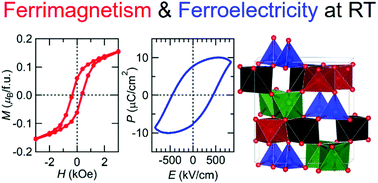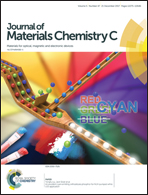Chemical tuning of room-temperature ferrimagnetism and ferroelectricity in ε-Fe2O3-type multiferroic oxide thin films†
Abstract
ε-Fe2O3-type iron oxide is a promising room-temperature multiferroic material. However, it is difficult to achieve the coexistence of large magnetization and reversible polarization due to large leakage current. In this study, we fabricated highly crystalline codoped ε-Fe2O3 films of A0.2Ga0.4Fe1.4O3 (A = Al, Ga, Sc, and In) and systematically investigated the doping effects on the magnetic and ferroelectric properties. All films are pure ε-phase and simultaneously exhibit in-plane ferrimagnetism and out-of-plane ferroelectricity at room temperature. Unlike the ε-Fe2O3 film, the films do not contain secondary phases such as α- or γ-phases, because the ε-phase is stabilized by Ga at the tetrahedral site. The Curie temperature, saturated magnetization, coercive field, and magnetic anisotropy of the films are enhanced upon decreasing the ionic radius of A, despite the same content of magnetic element (Fe3+ 3d5). These enhancements are derived from the increase in the amount of Fe ions at octahedral sites. Furthermore, we found that the leakage current significantly decreases with Sc doping, resulting in clear ferroelectric hysteresis loops in a wide frequency range at room temperature. Among the dopants in this study, codoping of Sc and Ga is the most promising method for obtaining a highly crystalline film with room-temperature large magnetization and reversible polarization with low leakage current.



 Please wait while we load your content...
Please wait while we load your content...